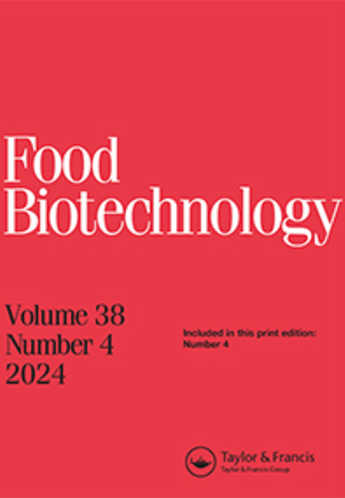Site-Directed Mutagenesis of Bile Salt Hydrolase (BSH) from Lactobacillus plantarum B14 Confirms the Importance of the V58 and Y65 Amino Acids for Activity and Substrate Specificity
IF 1.6
4区 农林科学
Q4 BIOTECHNOLOGY & APPLIED MICROBIOLOGY
引用次数: 0
Abstract
ABSTRACT The bile acids (BAs) de-conjugation is catalyzed by bile salt hydrolase (BSH) enzyme, that is an intestinal bacterial product and a member of the cholylglycine hydrolase (CGH) family. De-conjugated BAs alter BA-mediated signaling pathways such as glucose metabolism, energy homeostasis and lipid absorption and this makes the BSH clinically important. However, BSHs from different sources have a variable substrate preference to eight different bile salts. Although BSH is a well-studied enzyme, its molecular investigations based on BSH substrate recognition are not very well known. In this study, the relationship between substrate specificity of BSH from Lactobacillus plantarum B14 (LpBSH) and its loop II, the aliphatic-hydrophobic V58 and aromatic-hydrophobic Y65 residues in this loop was mutated and analyzed. While PCR-based site-directed mutagenesis was used to substitute V58 and Y65 amino acids for N58, F58, M58, C65, F65 and L65 amino acids, respectively, the BLR (DE3) strain of E. coli was used to express mutant recombinant LpBSHs (mrLpBSHs). Site-directed mutagenesis of LpBSH showed reduced activity of mrLpBSHs against six different BAs. Our results indicated that the V58 and mostly Y65 residues in loop II might be critical for the structural site that is involved in substrate specificity and catalysis. These findings suggested that V58 and Y65 residues of LpBSH might participate in substrate specificity and BSH substrate specificity may be dependent upon the collate group, rather than amino acid moieties. However, more mutagenesis-based investigation on other CGH family members are needed in order to understand the structure and substrate specificity relations of BSHs.植物乳杆菌B14胆汁盐水解酶(BSH)的定点突变证实了V58和Y65氨基酸对活性和底物特异性的重要性
胆汁酸(BAs)的脱偶是由胆汁盐水解酶(BSH)催化的,BSH是肠道细菌产物,是胆酰甘氨酸水解酶(CGH)家族的一员。去偶联的ba改变了ba介导的信号通路,如葡萄糖代谢、能量稳态和脂质吸收,这使得BSH在临床上具有重要意义。然而,来自不同来源的BSHs对8种不同的胆汁盐有不同的底物偏好。虽然BSH是一种被广泛研究的酶,但基于BSH底物识别的分子研究并不十分清楚。本研究对植物乳杆菌B14 (Lactobacillus plantarum B14, LpBSH) BSH的底物特异性与其环II、环中脂族疏水V58和芳族疏水Y65残基的突变关系进行了分析。采用基于pcr的位点诱变技术分别用V58和Y65代替N58、F58、M58、C65、F65和L65氨基酸,利用大肠杆菌BLR (DE3)菌株表达突变型重组LpBSHs (mrLpBSHs)。LpBSH的定点诱变表明,mrLpBSHs对6种不同BAs的活性降低。我们的研究结果表明,环II中的V58和大部分Y65残基可能对参与底物特异性和催化的结构位点至关重要。这些结果表明,LpBSH的V58和Y65残基可能参与底物特异性,BSH底物特异性可能依赖于collate基团,而不是氨基酸部分。然而,为了了解BSHs的结构和底物特异性关系,需要对其他CGH家族成员进行更多的诱变研究。
本文章由计算机程序翻译,如有差异,请以英文原文为准。
求助全文
约1分钟内获得全文
求助全文
来源期刊

Food Biotechnology
工程技术-生物工程与应用微生物
CiteScore
3.80
自引率
0.00%
发文量
15
审稿时长
>12 weeks
期刊介绍:
Food Biotechnology is an international, peer-reviewed journal that is focused on current and emerging developments and applications of modern genetics, enzymatic, metabolic and systems-based biochemical processes in food and food-related biological systems. The goal is to help produce and improve foods, food ingredients, and functional foods at the processing stage and beyond agricultural production.
Other areas of strong interest are microbial and fermentation-based metabolic processing to improve foods, food microbiomes for health, metabolic basis for food ingredients with health benefits, molecular and metabolic approaches to functional foods, and biochemical processes for food waste remediation. In addition, articles addressing the topics of modern molecular, metabolic and biochemical approaches to improving food safety and quality are also published.
Researchers in agriculture, food science and nutrition, including food and biotechnology consultants around the world will benefit from the research published in Food Biotechnology. The published research and reviews can be utilized to further educational and research programs and may also be applied to food quality and value added processing challenges, which are continuously evolving and expanding based upon the peer reviewed research conducted and published in the journal.
 求助内容:
求助内容: 应助结果提醒方式:
应助结果提醒方式:


